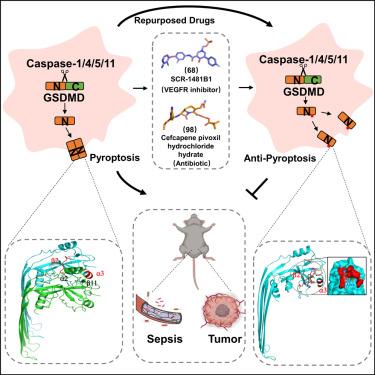当前位置:
X-MOL 学术
›
Cell Chem. Bio.
›
论文详情
Our official English website, www.x-mol.net, welcomes your
feedback! (Note: you will need to create a separate account there.)
Identification of two repurposed drugs targeting GSDMD oligomerization interface I to block pyroptosis
Cell Chemical Biology ( IF 6.6 ) Pub Date : 2024-10-31 , DOI: 10.1016/j.chembiol.2024.10.002 Yingchao Hu, Honghui Li, Xiangyu Zhang, Yuxian Song, Jun Liu, Jie Pu, Shuang Wen, Hongyang Xu, Hongliang Xin, Bingwei Wang, Shuo Yang
Cell Chemical Biology ( IF 6.6 ) Pub Date : 2024-10-31 , DOI: 10.1016/j.chembiol.2024.10.002 Yingchao Hu, Honghui Li, Xiangyu Zhang, Yuxian Song, Jun Liu, Jie Pu, Shuang Wen, Hongyang Xu, Hongliang Xin, Bingwei Wang, Shuo Yang

|
As an executor of pyroptosis, gasdermin D (GSDMD) plays a critical role in inflammatory diseases and cancer. Thus, GSDMD is currently being widely explored as a drug target. Existing inhibitors targeting GSDMD, such as necrosulfonamide, disulfiram, and fumarate, primarily prevent pyroptosis by modifying human/mouse C191/C192 in the N-terminal fragment of GSDMD. However, cysteine modification can prevent the function of important proteins or enzymes, thereby leading to adverse reactions. Here, we chose an alternative key intervention site for GSDMD activation, which is located at the oligomerization interface I of its pore-forming structure. Through high-throughput virtual and experimental screening and in combination with efficacy and pharmacological validation, we have identified two safe, specific “repurposed drugs” that potently suppress GSDMD-mediated pyroptosis. Moreover, the candidates exhibited synergistic therapeutic effects of “1 + 1>2” in murine sepsis and tumorigenesis models. These recently identified GSDMD inhibitors hold great promise for clinical translation in the development of anti-inflammatory and anti-cancer immunotherapies.
中文翻译:

鉴定两种靶向 GSDMD 寡聚化界面 I 的再利用药物以阻断焦亡
作为焦亡的执行者,gasdermin D (GSDMD) 在炎症性疾病和癌症中起着关键作用。因此,GSDMD 目前正被广泛探索为一种药物靶点。现有的靶向 GSDMD 的抑制剂,如坏死磺酰胺、双硫仑和富马酸盐,主要通过修饰 GSDMD N 端片段中的人/小鼠 C191/C192 来防止细胞焦亡。然而,半胱氨酸修饰可以阻止重要蛋白质或酶的功能,从而导致不良反应。在这里,我们选择了 GSDMD 激活的替代关键干预位点,该位点位于其成孔结构的寡聚化界面 I。通过高通量虚拟和实验筛选,并结合疗效和药理学验证,我们确定了两种安全、特异性的“再利用药物”,可有效抑制 GSDMD 介导的焦亡。此外,候选药物在小鼠脓毒症和肿瘤发生模型中表现出 “1 + 1>2” 的协同治疗作用。这些最近发现的 GSDMD 抑制剂在抗炎和抗癌免疫疗法的开发中具有巨大的临床转化前景。
更新日期:2024-10-31
中文翻译:

鉴定两种靶向 GSDMD 寡聚化界面 I 的再利用药物以阻断焦亡
作为焦亡的执行者,gasdermin D (GSDMD) 在炎症性疾病和癌症中起着关键作用。因此,GSDMD 目前正被广泛探索为一种药物靶点。现有的靶向 GSDMD 的抑制剂,如坏死磺酰胺、双硫仑和富马酸盐,主要通过修饰 GSDMD N 端片段中的人/小鼠 C191/C192 来防止细胞焦亡。然而,半胱氨酸修饰可以阻止重要蛋白质或酶的功能,从而导致不良反应。在这里,我们选择了 GSDMD 激活的替代关键干预位点,该位点位于其成孔结构的寡聚化界面 I。通过高通量虚拟和实验筛选,并结合疗效和药理学验证,我们确定了两种安全、特异性的“再利用药物”,可有效抑制 GSDMD 介导的焦亡。此外,候选药物在小鼠脓毒症和肿瘤发生模型中表现出 “1 + 1>2” 的协同治疗作用。这些最近发现的 GSDMD 抑制剂在抗炎和抗癌免疫疗法的开发中具有巨大的临床转化前景。






























 京公网安备 11010802027423号
京公网安备 11010802027423号